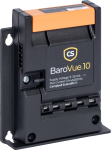Image Not Available
Retired Products
Related Documents
Product Brochures
Related FAQs
Number of FAQs related to Barometric Pressure Sensors: 12
Expand AllCollapse All
-
Zero downtime/recalibration
The BaroVue 10 has been designed to allow for zero downtime recalibration during normal use. Other sensors on the market need to be taken offline and sent back to the manufacturer to be recalibrated, often for weeks at a time, resulting in loss of data and costing time and money.
In comparison, the sensor card of the BaroVue 10 is calibrated ahead of time and sent out to customers to replace the old sensor card, requiring only one trip to the field and no downtime.
Further to this, the design of the BaroVue 10 allows customers to remove and replace their sensor card quickly and easily without having to disassemble the equipment in the enclosure or having to send the product back to the manufacturer. There is no need to turn the device off to replace the card.
Highly reliable measurements
The BaroVue 10 sensor card employs multiple sensor cells with statistical analysis to produce an accurate, precise, and repeatable measurement as well as a data-quality metric. The customer can use this quality metric for tracking calibration cycles, planning, maintenance schedules, and detecting pre-fault conditions.
Low power
The BaroVue 10 is a low power device and can be kept running continuously. The BaroVue 10 does not require any power cycling, unlike other products in this category.
Very low noise
The BaroVue 10 uses direct-to-digital sensors, and no analog-to-digital reconversion takes place inside the barometer.
These factors, coupled with the multiple sensor cells, result in a reduction in noise when compared with analog sensors.
Campbell Scientific aesthetics and form
The BaroVue 10 has been designed with functionality in mind, and its aesthetic complements other Campbell Scientific products.
The BaroVue 10 can be mounted in the orientation that best suits the application and has a smaller backplane footprint than its competitors.
-
Yes, but only if certain conditions are met:
- The sensor must reside in a non-condensing environment.
- The vent tube accessing the high-humidity environment must be extremely well desiccated to keep any moisture from reaching the sensor’s components. Moisture in the sensor will damage the sensor, often to an un-repairable state.
-
Contact your local Campbell Scientific office to purchase a calibrated BaroVue 10 sensor card (BVC10). After you receive the calibrated card, swap it with your current card, and mail it back to your local Campbell Scientific office. In this way, only one trip to the field site is required, and there will be no downtime for the sensor.
-
There is no warm-up time for the BaroVue 10.
-
The BaroVue 10 can fit inside an ENC100. For more information, refer to the Specifications information on the ENC100 product page.
-
When using SDI-12 or RS-232 communication protocols, the pressure measurement can be returned in hPa, kPa, mmHg, inHg, or PSI. Refer to the BaroVue 10 manual for more information. If different measurement units are required, refer to a conversion chart.
-
Campbell Scientific recommends calibration on a yearly basis. However, conformance to published standards or regulations may require this on a more frequent basis.
-
It is possible that an older version of Short Cut is being used. Download the latest version of Short Cut.
-
The quality metric is a unique diagnostic feature that indicates the quality of the pressure measurement returned by the sensor card (BVC10). It enables the user to monitor the health of their sensor to better schedule recalibrations.
Quality Metric Range Description Comments > 6
Sensor freshly calibrated
5 to 5.99
Sensor working well
4 to 4.99
In two to three months, this sensor will need to be recalibrated.
Within three months, send the BaroVue 10 to the factory for recalibration.
0 to 3.99
Recalibrate the sensor now.
As soon as possible, send the BaroVue 10 to the factory for recalibration.
-
One of the great benefits of the BaroVUE™10 is the ability to interchange sensor cards quickly and easily when the sensor needs re-calibration. This means that the serial number of the BaroVUE™10 and the BVC10 sensor card do not need to match in order to function. The calibration certificate you received with your product should have the same serial number as it is related to the BVC10 sensor card and not the BaroVUE™10.



